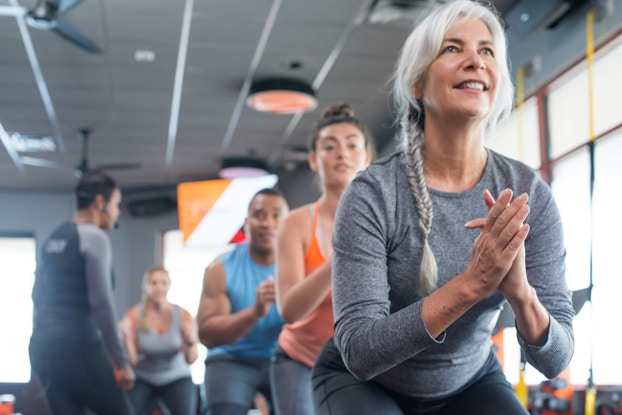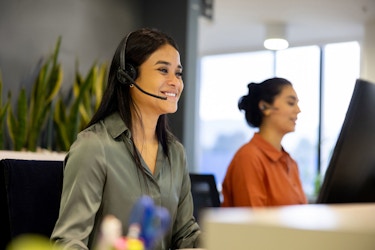
Baby boomers, Orangetheory co-founder Ellen Latham feels your pain. She’s one of you.
The woman who created the high-intensity workout — designed to boost the heart rate and keep the body burning calories long after the fitness class ends — knows what it’s like to need to adjust your exercise routine as you get older. Now she wants to spread the word that Orangetheory is a workout that’s a good fit for all ages.
Orangetheory has grown from one Florida studio in 2010 to 1,200 studios in 22 countries, with over 800,000 members and over $1 billion in sales today. It is a proven hit with 25- to 45-year-olds, the demographic group also most likely to hit the gym. (The fitness chain’s biggest customer cohort is females ages 25 to 49.)
Baby boomers, however, are underrepresented at Orangetheory and throughout the fitness industry. In the United States, 10,000 boomers turn 65 every day, and one in five Americans will be 65 or older by 2030.
The largest percentage of U.S. health club members — 44% — are 34 or younger, according to the International Health, Racquet & Sportsclub Association (IHRSA). Gen Xers are the next biggest category, at 33%, while members 55 and up are the smallest group at 23%.
Health club memberships in the United States generated $32.3 billion in revenue in 2018, the IHRSA reported.
Fitness chains that figure out how to attract seniors, while still keeping 20- to 45-year-olds happy, could see a healthy growth spurt, industry experts say.
Latham believes Orangetheory is ideally positioned to make that leap.
This kind of training — I call it the multi-vitamin of metabolic training in terms of fighting cellular decline — has done incredibly well for me as a 63-year-old woman.Ellen Latham, co-founder, Orangetheory
Accommodate
The premise behind Orangetheory's workout is to accommodate exercisers of all levels and ages. Read more on ways your business can adapt to and retain your customers.
Group classes, individual focus
While its business model is based on group classes, Orangetheory’s heart rate monitors, display screen, connected treadmills, other equipment, and mobile app, in effect, allow members to compete against themselves by measuring individual heart rates and performance goals.
Class members pick the level they want to work at, and are coached on how to adjust the exercises to accommodate special needs.
Latham said she is hearing from growing numbers of baby boomers who have tried Orangetheory and liked it.
“As the creator of the workout, and someone who is climbing through her 60s, I get emails, a lot of them from baby boomers, who say, ‘You know I was frightened of this Orange place, but I walked in there and there was a walker category, a jogger category, and a runner category, so I chose the walker category and I was successful,’” said Latham.
Latham said Orangetheory coaches are trained to help members adjust the exercises in the group classes to accommodate their bodies. It’s a method that works for a 60-year-old with stiff knees, or a 25-year-old recovering from a sports injury.
“You pick an option that works for you and work on getting better,” Latham said.
Metabolic multi-vitamin
At 63, Latham has had to modify her own workouts because of her arthritic knees. But she still does Orangetheory interval training three times a week.
“This kind of training — I call it the multi-vitamin of metabolic training in terms of fighting cellular decline — has done incredibly well for me as a 63-year-old woman,” she said.
The Orangetheory workout, which grew out of a class she developed as a Pilates instructor, is designed to be “a workout that a person would age very well with,” Latham said.
The workout is built around developing functional and usable strength, “which means I’m interested in people when they are 60, 70, 80 being able to get up off the floor — not how much weight you can lift,” she said.
Latham and Orangetheory executives are also hoping to leverage the data they have collected showing how members have improved their heart function to convince health care providers or insurers to prescribe exercise, or subsidize it, as part of a wellness program.

Capturing the (flush) ‘well-elderly’ market
Walter Thompson, past president of the American College of Sports Medicine (ACSM) and associate dean in the College of Education and Human Development at Georgia State University, said Latham is smart to be reaching out to boomers.
“She understands that there is this huge group of people who are retired who are the well elderly,” Thompson told CO—. “It used to be 20 to 30 years ago that the 65-plus bracket was the frail elderly.” Today’s retirees are more fit and active, he said.
“And quite frankly,” Thompson said, “they’re the emerging group that has the most discretionary money.”
The ACSM’s annual survey of health and fitness professionals identified programs for older adults as one of the top fitness trends for 2019.
But don’t label those programs as being for “seniors” or the “old,” warned Meredith Poppler, vice president, communications and leadership engagement for the IHRSA.
“The first and most important piece of advice for clubs looking to cater to older adults is to avoid stereotypical old names like ‘golden’ or ‘senior’ in programs,” Poppler told CO—.
That way, programs can attract all ages, she said. Not only do baby boomers resist defining themselves as old, but a younger member with a knee injury is more likely to take advantage of an aquatics class if it isn’t labeled “senior” or “golden,” she said.
“Older adults, in particular, want and need training to help them live life better and fuller, [and to gain] better endurance to care for grandkids, better balance to not fall, and better bone and muscle strength,” she said.
The Orangetheory slogan is “more life” and it was adopted, Latham said, because she and her co-founders wanted the workouts to be about more than losing weight or getting toned. “We truly have great interest in giving people more life.”
That applies, she said, to everyone, no matter how long they have lived.
If you are a baby boomer who thinks you are too old or out-of-shape for a workout, Latham has this advice: Go to an Orangetheory studio, and say “Ellen said to give me options.”
CO— aims to bring you inspiration from leading respected experts. However, before making any business decision, you should consult a professional who can advise you based on your individual situation.
CO—is committed to helping you start, run and grow your small business. Learn more about the benefits of small business membership in the U.S. Chamber of Commerce, here.







